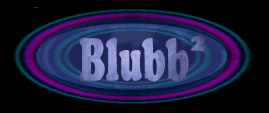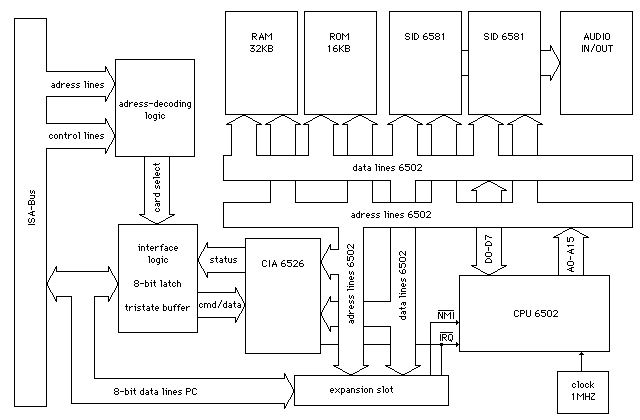
The Blubb2 Soundcard
Some time ago, we (namely Markus Hadwiger and Andreas Varga) set ourselves
to developing our own soundcard for PCs and Compatibles using the beloved
SID 6581 tone-generator which had been the very heart of famous C64's highly
praised sound-generation capabilities.
First, we want to tell you a little bit about the history of the so
called Blubb2 soundcard (originally short for Blubb-Blubb; wondering how
non-native German-speakers are gonna pronounce that properly - in German we call
a bubbling sound "blubb" and we've always liked rather childish
names for electronic devices :-), and thereafter dive into some serious implementation
details...
Here goes:
Back in the year 1992, when both of us were attending a school for communications
and electronics in Vienna (Austria, Europe), we had to come up with an idea
for a two-years project to do in the fourth and fifth grade (which were
our last two years at school and hence it ought to have the character of
a graduation-project). Since we were both skilled at digital electronics and
assembly language programming and had been interested in electronic music
and sound for quite a long time, we finally decided to design and build
our own soundcard for PCs and Compatibles. But as the Soundblaster series
was already widely in use at the time we didn't want to build some sort
of a boring clone. Well, we had also been longtime C64 enthusiasts and had
already considered using the SID 6581 for music on the PC some time earlier
on.
So we settled on using the good old SID as tone-generator on our forthcoming
soundcard-project. But we didn't want to stick with three-voice mono sound
and therefore planned to use two 6581s - one for the left, and one for the
right channel, respectively.
The next decision we made after having decided to build an 8-bit ISA card
using two SIDs (we'd never quite wanted to use the parallel port for attaching
a sound generating device because it didn't seem very flexible and clean
to us, so the choice of the ISA bus had been an easy one), was whether we
should try to map the 6581's registers directly into the PC's (I/O-)address
space. Considering the problems with this approach regarding the vastly
differing timings of the whole 65xx family of ICs and the ISA bus (which
we would have had to use to map the registers directly) we were after something
else. Moreover, we wanted to emphasize the hardware and embedded systems
programming aspect of the project and hence didn't want to use the 80x86
for playing music. Thus, we decided to incorporate a complete microprocessor-system
which should manage communication to PC applications software and be completely
responsible for playing music and sound. Guess what! Of course we took the
obvious approach to avoid potential timing conflicts and hours of hardware-debugging
and used a 6502 as CPU which had exactly the timing specifications we needed
to control our two SIDs (btw, a big thanx to Chuck Peddle for this hell of
a CPU!). Anyway, a little bit 6502 coding after quite a while of doing x86
stuff should be rather refreshing! Furthermore, a big advantage of our approach
was that we wouldn't need the PC's processor-time for sound output at all. The
only drawback emerging from the use of an independent processor-system was
that we had to transfer complete song-data into the card's proprietary memory
prior to playing a song. But what the heck! I haven't mentioned the biggest
advantage yet. Hadn't we used a 6502 compatible CPU we would have had to
write an 6502 emulator running on the host to enable our card to play back
the loads of cool C64 sounds we all have come to love, and the problem of
mapping the 6581's registers directly would have kicked in again! Not only
that this emulator would have used precious x86 processor time, I guess
we never would have heard familiar 64 tunes while running Windows(tm) :-)
By the way, I've already mentioned that we wanted to emphasize the hardware-related
part of the project and so our solution seemed very sensible to us. After
one year of hard work :) we had managed to build a first prototype version
of the Blubb2 soundcard and, surprisingly enough, it worked reasonably
well! (although
we won't deal with the black art of hardware debugging and the debugging
of embedded systems software without the proper tools here...:-)
The second year of the project went into refining and adding features, as
well as fixing some nasty problems (ever tried to reset a 1MHz CPU that
needs a reset pulse of at least three cycles using the ISA RESET#-line without
precautions??). Along the way of refining the hardware we also found a little
time for writing a kernel somewhat worth its name (the prototype used systems
software only capable of doing what was absolutely necessary to get the
card up and running) and putting together some documentation stuff. Unfortunately,
a very much improved version of the interface to the ISA-bus didn't quite
make it into a PCB (printed-circuit-board) because we weren't able to figure
out a cheap way of producing a second PCB (and the prototype's PCB did a
rather good job anyway).
Btw, one of the most delighting experiences during these two years has been
the first time when the prototype actually did something which made sense
to us :-) We had hooked logic analyzer probes all over the PCB and were
single-stepping through the boot procedure (and I'm talking hardware-tracing
here!). Can imagine the feeling when we saw the address lines properly referencing
the first few addresses of the boot-code, proving that the processor-system
worked entirely??!! Alright, come to think one has to experience this on
his own to know what I'm talking about ;-)
Well, thus far concerning the history of our little project. It seems to
me that some implementation details would be in order right now, so here
we go:
- 8-bit ISA card
- 6502 8-bit/1MHz CPU to keep everything up and running
- 6526 for various I/O purposes including managing communication to PC
applications software and providing the tick-interrupt for music-output
- Two 6581 tone-generators yielding six-voice stereo output
- 32KB static RAM (yes, we really didn't want to cope with dynamic refreshing!)
- 16KB ROM (EPROM, of course) divided into two banks to save 6502 address-space
- Lotsa TTL gates for everything else (alas, we weren't able to use ASICs
at the time)
And here's a block diagram of the card:

The ROM contains the Blubb2 kernel which communicates with PC applications
software, manages onboard-memory and system-resources, and - above all - runs
the sound-routines playing SID music.
When the card is reset for the first time, the boot-code initializes the
6526 to provide a 50Hz tick-interrupt utilized as timebase for music-routines.
Communication is done using a single port (although as much as four ports
are decoded for expansion purposes, see below). Reading this port provides
status information; write access uses a proprietary protocol for controlling
the card's operation and transferring data to it.
Usually one has to transmit a single block containing the player-routine
as well as the music/sound data prior to playing sound. Player-routines
have to use a standardized header format to enable the kernel to use them.
Having transferred everything needed, one uses the PLAY MUSIC command to
provide the routine with the 50Hz tick-interrupt.
Commands supported by the card generally belong to one of the following
categories:
- Music Control Commands like playing, pausing or stopping music-output.
- Transfer Commands like transferring musicdata or kernel extensions.
- Miscellaneous Commands like requesting status or the firmware version number.
- Initialization Commands like resetting the card or querying its presence.
The second version of the card (post-prototype) utilizes a 40-pin connector
to allow daughterboard's interfacing to card-internal signals. This feature
provides the means to mapping additional devices into the card's address
space and using its I/O channels. Three of the four PC I/O-ports decoded
by the card's address decoding circuitry are available to be used by extension-boards
(e.g. a MIDI interface). But of course hardware alone doesn't suffice to
extend the card's possibilities and hence a kernel extension feature has
been implemented, allowing the user to extend the basic (rather generic)
kernel in a documented way. For this purpose a TRANSMIT KERNEL EXTENSION
MODULE command is available as well as various hooks into the kernel itself
are provided.
Yep, that's enough for a brief summary I deem, but apologize in advance
for having stayed rather superficial most of the time due to time and space
constraints.
Comments on this page and the Blubb2 soundcard project appreciated
at e9425555@stud1.tuwien.ac.at
(Markus Hadwiger)
If you are interested in performance programming utilizing 100 percent assembly
language, games programming, developing sound systems, hardware design,
embedded systems design and programming (not necessarily in this order) or anything
you think might be of interest to me, then please don't hesitate to drop me
a line.
This text copyright (c) 1995 by Markus Hadwiger
Blubb2 design, hardware, firmware and related material copyright (c) 1992-1994
by Markus Hadwiger and Andreas Varga
All Rights Reserved.



